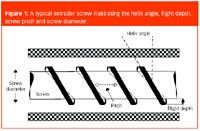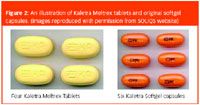News
Article
Pharmaceutical Technology Europe
Pharmaceutical Technology Europe
Hot-melt extrusion: an emerging drug delivery technology
Author(s):
Hot-melt extrusion offers many advantages compared with conventional solid dosage form manufacturing, and has consequently received considerable attention from both the pharmaceutical industry and academia as a novel drug delivery technology. The possibility of forming solid dispersions with improved bioavailability renders hot-melt extrusion an excellent alternative to other conventionally employed techniques.
Hot-melt extrusion (HME) is an established process that has been used since the early 1930s, predominately in the plastics manufacturing industry, but also in the food processing industry. Currently, more than half of all plastic products, including bags, sheets, and pipes, are manufactured using HME.1 Since the advent of plastics production, polymers have been melted and formed to different shapes for a variety of industrial and domestic applications. Extrusion can be simply defined as the process of forming a new material (the extrudate) by forcing it through an orifice or die under controlled conditions,2 such as temperature, mixing, feed-rate and pressure.

Paul Souders/Getty Images
The HME process
At the most fundamental level, an extruder consists of a platform that supports a drive system, an extrusion barrel, a rotating screw arranged on a screw shaft and an extrusion die for defining product shape. Typically, process parameters are controlled via connection to a central electronic control unit. The extrusion drive system generally comprises motor, gearbox, linkage and thrust bearings, whereas the barrel and screw is commonly utilized in a modular configuration.3 Simple single screw arrangements consist of only a single rotating screw inside a stationary extruder barrel, whereas more advanced machines involve twin-screw systems utilizing either a corotating or counter-rotating screw configuration. It is common for the extrusion screw to be characterized by the length/diameter (L/D) ratio, which typically ranges from 20 to 40:1. Typical pilot plant extruders have diameters ranging 18–30 mm, whereas production machines are much larger with diameters typically exceeding 50 mm. Irrespective of the complexity of the machine, the extruder must be capable of rotating the screw(s) at a selected speed while compensating for the torque generated from the material being extruded.
A simple single screw extrusion system comprises one rotating screw inside a stationary barrel that may be conveniently subdivided into three distinct zones: feed zone, compression zone and metering zone. The depth and/or pitch of the screw flights differ within each zone, generating variable pressure along the screw length (zone dependent). Because of the large screw flight depth and pitch, the pressure within the feed zone is very low, allowing for consistent feeding from the hopper and gentle mixing of API and excipients (Figure 1). The primary function of the subsequent compression zone is to melt, homogenize and compress the extrudate so that it reaches the metering zone in a form suitable for extrusion. Consequently, the compression zone must impart a high degree of mixing and compression to the material. This is achieved by decreasing the screw pitch and/or the flight depth, resulting in a gradual increase in pressure along the length of the compression zone.4 The final section, the metering zone stabilizes the pulsating flow of the matrix, thus ensuring the extruded product has a uniform thickness. Constant screw flight depth and pitch helps maintain continuous high pressure to ensure a uniform delivery rate of molten material through the extrusion die and, hence, a uniform product.

Figure 1
At a minimum, a screw extruder consists of three distinct parts:
- a conveying system for material transport and mixing
- a die system for forming
- downstream auxiliary equipment for cooling, cutting and/or collecting the finished product.
Individual components within the extruder are the feed hopper, temperature controlled barrel, rotating screw, a die and heating/cooling elements. Additional systems include mass flow feeders to accurately meter materials into the feed hopper, PAT to measure extrudate properties (near infra red systems and laser systems), liquid and solid side stuffers, vacuum pumps for degassing, pelletizers and calendaring equipment. Standard process control and monitoring devices include zone temperature and screw speed with optional monitoring of torque, drive amperage, melt pressure and melt viscosity. Temperatures are normally controlled by electrical heating bands and monitored by thermocouples.
Single-screw extrusion is a fundamental operation for polymer processing. It is used to increase pressure within a polymer melt, allowing extrusion through a die or injection into a mould. Although a relatively simple process, singlescrew extrusion does not possess the mixing capability of a twin-screw machine and is, therefore, not the preferred approach for the production of pharmaceutical formulations. Moreover, the versatility of a twin-screw extruder (process manipulation and optimization) and the ability to accommodate various pharmaceutical formulations makes this set-up much more favourable. In relation to machine design, rotation of the screws inside the extruder barrel may either corotate (same direction) or counter-rotate (opposite direction); both directions being equivalent from a processing perspective. Another significant design variable is whether the two screws are intermeshing or nonintermeshing, the former being preferred because of the greater degree of conveying achievable and the shorter residence times. Additionally, the configuration of the screws themselves may be varied using forward conveying elements, reverse conveying elements, kneading blocks and other designs to achieve particular mixing characteristics.5
Twin-screw extrusion offers the pharmaceutical formulator a rapid, continuous process that has much better mixing capability than singlescrew extrusion. Moreover, twinscrew extrusion provides a more stable melting process, shorter residence times and significantly greater output. Industrially, twinscrew extrusion has become extremely favourable because of process practicality and the ability to combine separate batch operations into a single continuous process, thus increasing manufacturing efficiency. In recent years, FDA has published guidance to the pharmaceutical industry to enhance and modernize the manufacture of pharmaceutical products to produce better quality products.6 The guidance facilitates the introduction of new technologies to improve the efficiency and effectiveness of manufacturing process design, control and quality assurance. Two key areas where this has been progressed are in the move toward continuous manufacturing processes and the implementation of PAT to monitor, control and understand manufacturing processes. HME is a process that lends itself well to continuous, lean manufacturing principles, and the implementation of in-line measurement and control technologies.
Research developments
HME technology is being explored and used in the pharmaceutical industry and academia because of several advantages compared with traditional processing methods.7 Not only is it an efficient manufacturing process, it may also enhance the quality and efficacy of manufactured products.8 Of particular interest is the use of HME to disperse APIs in a matrix at the molecular level, thus forming solid solutions. HME is an approach utilized in the delivery of poorly water-soluble, class II compounds because of the increased dissolution achievable, and improved absorption and therapeutic efficacy.9,10 Whilst the formation of solid solutions may significantly enhance drug dissolution rate in vivo, the presence of a metastable state, high internal energy and specific volume of the amorphous state leads to a tendency during storage (thermal and/or humidity stress) towards recrystallization. Extruded solid solutions offer greater thermodynamic stability than those prepared by alternative processes such as spray drying, solvent evaporation and other hotmelt methods.11 Moreover, HME offers many advantages compared with traditional processing techniques that have been typically used to produce oral solid dosage forms. In particular, solvents are not required, which makes the process more environmentally friendly and cost effective; fewer unit batch operations are required than in traditional dosage form manufacture, and improved content uniformity because of intense mixing and agitation may be achieved. Furthermore, the polymeric components used in the extrusion process may function as thermal binders, drug stabilizers, drug solubilizers and/or drug release controlling excipients with no compressibility requirements. Typical examples of pharmaceutically approved polymeric materials include vinyl polymers (polyvinylpyrrolidone [PVP]), PVPvinyl acetate [PVP-VA]), polyethylene oxide (PEO), Eudragit (acrylates), PE glycol (PEG) and cellulose derivatives (hydroxypropylcellulose [HPC], hydroxypropylemethylcellulose [HPMC], HPMC acetate succinate [HPMCAS], cellulose acetate [CA] and CA-phthalate [CAP]). While residence time within the extruder and highprocessing temperatures (required to melt the polymeric carrier) were initially projected as significant disadvantages of this technology, the ability to modify screw configuration and the high shear forces generated within the extruder allow for processing at lower temperatures, coupled with the use of plasticizing agents and the introduction of twinscrew extruders, removed such concerns. Typical plasticizing agents for HME include PEGs,12 triacetin,13 citrate esters,14 and citric acid.15 However, APIs have also been shown to be effective plasticizers in many cases.16 These plasticizers occupy sites along the polymer chain, reduce polymer–polymer chain secondary bonding and provide more mobility for the macromolecules, resulting in a softer, more easily deformable mass,17 thus improving process ability.
Although initial investigations focused on the effects of formulation and processing variables on the properties of the final dosage form,12,18,19 more recent scientific articles have described the use of HME for the manufacture of solid dispersions and for the development of minimatrices. Early work by De Brabander et al.,20 described the preparation of matrix minitablets that minimize the risk of dose dumping, reduce inter- and intrasubject variability and provide highly dispersive formulations within the gastrointestinal tract. This was complemented by further investigations into the properties of sustained release minimatrices manufactured from ethyl cellulose, HPMC and ibuprofen.21 The potential of HME to produce a sustained release, matrix-in-cylinder device, was conducted by Mehuys et al.22 A fourfold increase in the bioavailability of propanolol was observed when comparing the HME formulation with a commercially available formulation (Inderal; AstraZeneca, Belgium).
During the last 5 years, there has been a significant increase in the use of HME for the manufacture of drug delivery systems. It has been used to manufacture granules, pellets, immediate and modified release tablets, transmucosal/trandermal films and implantable reservoir devices;13,14,16,18,23,24 for example, with respect to oral drug delivery, molecular solid dispersions of nifedipine,25 nimodipine26 and itraconazole27 have been successfully produced using HME technology. In a recent article by Chokshi et al.,28 stable, amorphous indomethacin dispersions have been manufactured using pharmaceutically acceptable hydrophilic polymers. Sustained release pellets have been successfully developed by Young et al.,29 whereas HME floating tablets have been examined by Fukuda et al.30 Additionally, targeted drug delivery systems, including enteric matrix tablets and capsules systems, have been extruded.31,32 More recently, Miller et al.,33 have demonstrated the ability of HME to act as an efficient dispersive process for aggregated, fine engineering particles to enhance their wettability and improve dissolution rate properties.

Figure 2
Current marketed products
Current interest in HME technology is growing rapidly with in excess of 100 papers published in the scientific literature during the last decade. Germany and the US and Germany hold approximately more than half (56%) of all issued patents.34 Despite this increased interest, there are few commercialized HME pharmaceutical products currently marketed.
Several companies specialize in the use of HME as a drug delivery technology including PharmaForm (TX, USA) and SOLIQS (Germany). SOLIQS has developed a proprietary Meltrex formulation and redeveloped a proteaseinhibitor combination product, Kaletra, for the treatment of human immunodeficiency virus (HIV) (Figure 2). The formulated HME product significantly enhanced the bioavailability of both APIs.35 Moreover, HME Kaletra tablets were shown to have significant advantages for the patient compared with the previous soft gel capsule formulation, such as reduced dosing frequency and improved stability, as evidenced by FDA's decision to fasttrack approval. In addition, SOLIQS has also developed a fast-onset ibuprofen system and a sustained release formulation of verapamil (Isoptin SRE) that was the first directly shaped HME product on the market.
Similarly, PharmaForm, a service provider for HME R&D has published more than 40 peerreviewed publications on the topic and has developed significant intellectual property. One proprietary melt extrusionbased technology, PharmaForm Abuse Deterrent Technology (PADT), has been developed to deter and prevent drug abuse. This technology utilizes HME to produce a drug delivery platform that helps prevent rapid drug absorption and the desired euphoric effect. The drug delivery technology offered by the company provides a solution to this problem as the dosage forms are very difficult to chew and/or crush. Additionally, PADT systems prevent alcoholinduced dose-dumping and alcohol extraction by maintaining sustained release characteristics in 40% alcohol, comparable to the release in water or normal dissolution media, for more than 3 h.
The use of HME to improve oral bioavailability has been detailed in numerous scientific articles and patents. A recent study examined the performance of itraconazole melt extrudates prepared using HPMC and PVP-VA/Eudragit E polymeric platforms. In this specific example, HPMC was shown to significantly increase the area under the plasma concentration time curve compared with the other extrudates, despite having a slower dissolution rate.36 One conclusion drawn from this work is that dissolution rate may not always be the most important factor when screening such formulations; inhibition of precipitation from a supersaturated state may be more important. More recently, HPMCAS has been shown to be of particular benefit in the preparation of solid dispersions and for the production of enteric dosage forms.31,37 Industrially, Pfizer has used HPMCAS solid dispersions prepared by a spray drying method to significantly enhance AUC for a number of their poorly soluble drugs compared with conventional formulations.38 The acetyl and succinate groups present within HPMCAS provide sufficient capacity for API/polymer hydrogen bonding; secondary forces that have been shown to be highly significant in the formation and stabilization of solid dispersions.39
Future of the technology
The application of HME technology in the pharmaceutical industry has tended to focus on the development of bio-enhanced formulations to increase the efficacy of poorly watersoluble compounds. Whilst this will probably remain the major focus for the pharmaceutical industry, there has also been an increase in the application of HME for the development of controlled release formulations, in the form of pellets, beads or minimatrices, and as a means to facilitate the continuous processing of products to reduce the number of manufacturing unit operations.8,40 Moreover, there have been several articles investigating the application of HME technology for the production of transdermal or bioadhesive films,41,42 and as a compounding process for the production of a high-density powder for subsequent compression into a conventional oral dosage form.43 Recent studies have also demonstrated the production of biocompatible shape-memory polymers for use in biomedical applications, using HME as a manufacturing process.44 The production of multiparticulate dosage forms using HME has been investigated using hotmelt pelletization29 and, lately, the use of die face-cutting the polymer extrudate to produce HME pellets shows the continuing utilization of technology from the plastics industry for pharmaceutical manufacturing.45 The scope of the technology has also been broadened to expand the range of polymers and APIs that can be processed through application of supercritical fluid assisted HME.46 Similar work by Verreck et al.47 has shown that pressurized carbon dioxide can reduce the processing temperature of pamino salicylic acid, a thermally labile API, extruded in ethyl cellulose. This research demonstrates that using supercritical fluids to reduce the melt viscosity of polymers enables the HME process to operate at lower temperatures, thereby lowering the risk of API degradation. It has also been recognized that HME is a robust, solvent-free manufacturing process for the production of films, which may present future opportunities to develop gastroretentive films for prolonged drug delivery, and multilayer films to modulate drug release for oral and transdermal applications. A multilayer gastrointestinal mucoadhesive patch system (GI-MAPS) for the oral delivery of proteins has been reported by Eiamtrakarn et al.,48 (2002) and although the films were solventcast, a HME process would also offer a rapid, solventfree alternative manufacturing process for the polymers described.
The growing market in medical devices, including those that incorporate drugs such as biodegradable stents and drugloaded catheters, will require HME manufacturing processes to be commercialized, and may lead to new areas of collaboration across pharmaceutical, medical device and biotechnology research. The breadth of research and published articles demonstrates that HME is a versatile processing technology for the pharmaceutical industry and has exciting prospects for the future.
Gavin P. Andrews is a lecturer at the School of Pharmacy at Queen's University Belfast (UK).
Daniel N. Margetson is a PhD student at Queen's University Belfast (UK).
David S. Jones is the Chair of biomaterial science at the School of Pharmacy at Queen's University Belfast (UK).
Mark S. McAllister is from Pfizer.
Osama Abu Diak is a PhD student at the School of Pharmacy at Queen's University Belfast (UK).
References
1. H.S. Kaufman and J.J. Falcetta Introduction to Polymer Science and Technology (John Wiley & Sons, New York, USA, 1977).
2. J. Breitenbach, European Journal of Pharmaceutics and Biopharmaceutics, 54(2), 107–117 (2002).
3. T. Whelan and D. Dunning (Eds.), The Dynisco Extrusion Processor Handbook, 1st Edition (London School of Polymer Technology, London, UK, 1996).
4. R.J. Crawford, Plastics Engineering (Butterworth-Heinemann, Oxford, UK, 1998).
5. J.L. White, Twin Screw Extrusion: Technology and Principles (Hanser/Gardner Publications Inc., Cincinnati, OH, USA, 1991).
6. FDA Guidance for Industry — Pharmaceutical cGMPs for the 21st Century: A Risk-Based Approach, September 2004. www.fda.gov
7. J.W. McGinity et al., American Pharmaceutical Review, 4(2), 25–36 (2001).
8. I. Ghebre-Sellassie and C. Martin (Eds.), Pharmaceutical Extrusion Technology, (Marcel Dekker Inc., New York, USA, 2003).
9. W.L. Chiou and S. Reigelman, J. Pharm. Sci., 60(9), 1281–1302 (1971).
10. J.L. Ford, Pharmaceutica Acta Helvetiae, 61(3), 69–88 (1986).
11. J.E. Patterson et al.,Int. J. Pharm., 336(1), 22–34 (2007).
12. F. Zhang and J.W. McGinity, Pharmaceutical Development and Technology, 4(2), 241–250 (1999).
13. N. Follonier, E. Doelker and E.T. Cole, Drug Dev. Ind. Pharm. , 20(8), 1323–1339 (1994).
14. C. Aitken-Nichol, F. Zhang and J.W. McGinity, Pharmaceutical Research, 13(5), 804–808 (1996).
15. S.U. Schilling et al., J. Pharm. Pharmacol., 59(11), 1493–1500 (2007).
16. M.A. Repka and J.W. McGinity, Biomaterials 21(14), 1509–1517 (2000).
17. M. Rahman and C.S. Brazel, Progress in Polymer Science, 29(12), 1223–1248 (2004).
18. M.M. Crowley et al., Biomaterials, 23(21), 4241–4248 (2002).
19. J.P. Liu, F. Zhang and J.W. McGinity, European Journal of Pharmaceutics and Biopharmaceuticals, 52(2) 181–190 (2001).
20. C. De Brabander et al., Int. J. Pharm., 199(2), 195–203 (2000).
21. C. De Brabander, C. Vervaet and J.P. Remon, J. Contr. Release, 89(2), 235–247 (2003).
22. E. Mehuys et al., J. Contr. Release, 96(2) ,261–271 (2004).
23. B. Perissutti et al., European Journal of Pharmaceutics and Biopharmaceutics 53(1), 125–132 (2002).
24. R.J. Chokshi et al., J. Pharm. Sci., 94(11), 2463–2474 (2005).
25. L. Li, O. AbuBaker and Z. Shao, Drug Dev. Ind. Pharm., 32(8), 991–1002 (2006).
26. X. Zheng et al., Drug Dev. Ind. Pharm., 33(7), 791–802 (2007).
27. G. Verrick et al., Int. J. Pharm., 251(1–2), 165–174 (2003).
28. R.J. Chokshi et al., J. Pharm. Sci., 97(6), 2286–2298 (2008).
29. C.R. Young, J.J. Koleng and J.W. McGinity , Int. J. Pharm., 242(1–2), 87–92 (2002).
30. M. Fukuda, N.A. Peppas and J.W. McGinity, J. Contr. Release, 115(2), 121–129 (2006).
31. E. Mehuys, J.P. Remon and C. Vervaet, Eur. J. Pharm. Sci., 24(2–3), 207–212 (2005).
32. G.P. Andrews et al. , European Journal of Pharmaceutics and Biopharmaceutics, 69(1), 264–273 (2008)
33. D.A. Miller et al., J. Pharm Sci., 96(2), 361–376 (2007).
34. M.M. Crowley et al., Drug Development and Industrial Pharmacy, 33(9), 909–926 (2007).
35. C.E. Klein et al., J. Acquir. Immune Defic. Syndr., 44(4), 401–410 (2007).
36. K. Six et al., Eur. J. Pharm. Sci., 24(2–3), 179–186 (2005).
37. F. Tanno et al., Drug. Dev. Ind. Pharm., 30(1), 9–17 (2004).
38. W.J. Curatolo, S.M. Herbig and A.J.S. Nightingale, European Patent 1745774 (2007).
39. H. Konno and L. Taylor, J. Pharm. Sci., 95(12), 2692–2705 (2006).
40. H.M. Wolff, Pharmaceutical Science and Technology Today, 3(5), 173–181 (2000).
41. M.A. Repka and J.W. McGinity, J. Contr. Release, 70(3), 341–351 (2001).
42. P.K. Mididoddi, S. Prodduturi and M.A. Repka, Drug Dev. and Ind. Pharm., 32(9), 1059–1066 (2006).
43. M.A. Repka et al., Drug Dev. Ind. Pharm., 33(10), 1043–1057 (2007).
44. A. Lendlein and R. Langer, Science, 296(5573), 1673–1676 (2002).
45. A. Gryczke,1st International Symposium on HotMelt Extrusion, (Frankfurt, Germany, 21–22 March 2007).
46. J.G. Lyons et al., Int. J. Pharm., 329(1–2), 62–71 (2007).
47. G. Verreck et al., Int. J. Pharm., 327(1–2), 45–50 (2006).
48. S. Eiamtrakarn et al., Biomaterials, 23(1), 145–152 (2002).
Newsletter
Get the essential updates shaping the future of pharma manufacturing and compliance—subscribe today to Pharmaceutical Technology and never miss a breakthrough.






